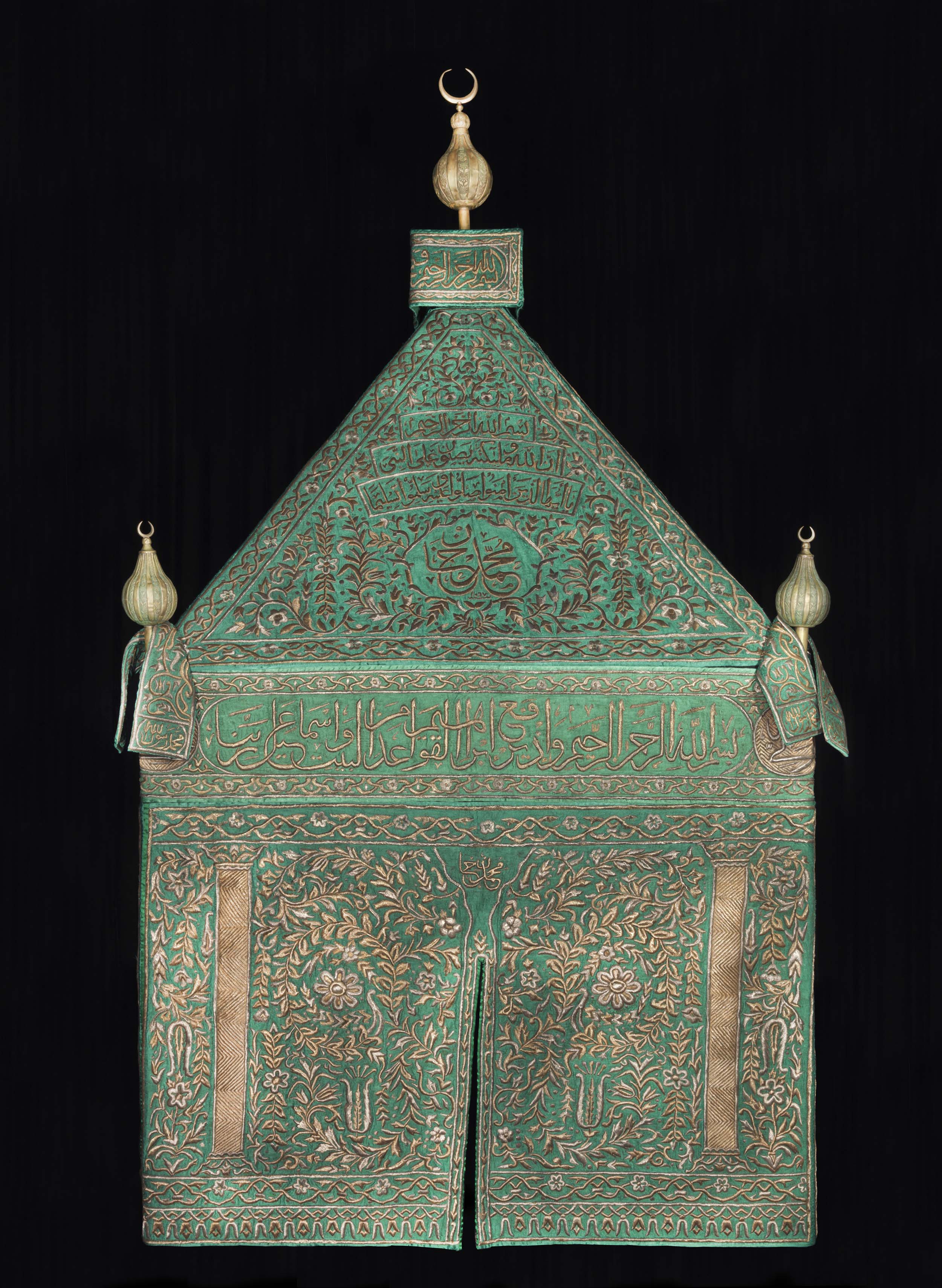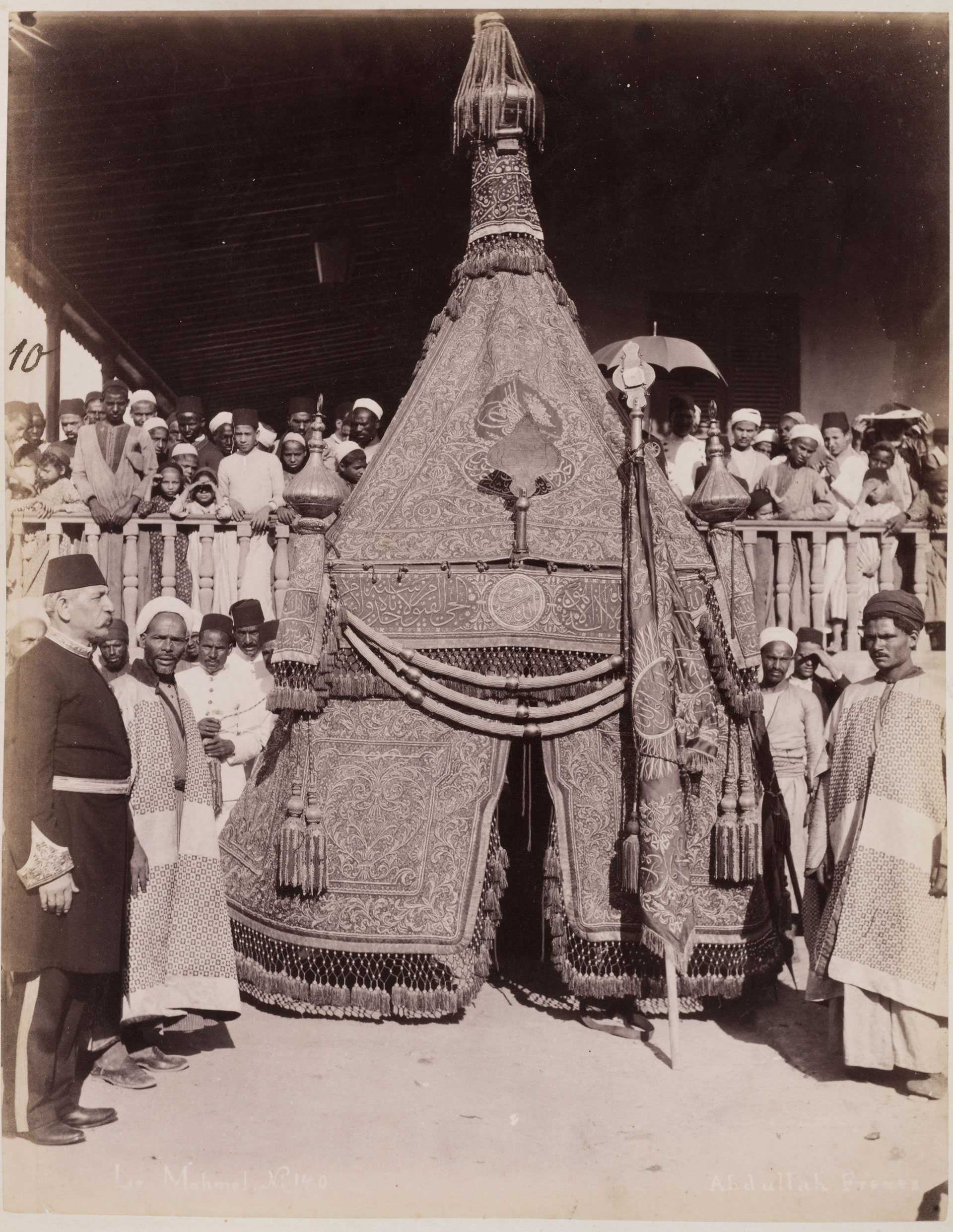Mahmal on:
[Wikipedia]
[Google]
[Amazon]
 A mahmal ( ar, مَحْمَل, maḥmal) is a ceremonial passenger-less litter that was carried on a camel among caravans of pilgrims on the
A mahmal ( ar, مَحْمَل, maḥmal) is a ceremonial passenger-less litter that was carried on a camel among caravans of pilgrims on the
 The first recorded sending of a mahmal was by
The first recorded sending of a mahmal was by  The arrival of the mahmal in Mecca was a significant occasion which local people and pilgrims came out to watch. Before entry to the city, the simple textiles which had covered the mahmal on its journey across the desert or sea were replaced with the ornate, colourful ''kiswah''. Mahmals from different countries would vie for the best position in front of the
The arrival of the mahmal in Mecca was a significant occasion which local people and pilgrims came out to watch. Before entry to the city, the simple textiles which had covered the mahmal on its journey across the desert or sea were replaced with the ornate, colourful ''kiswah''. Mahmals from different countries would vie for the best position in front of the
Khalili Collection Hajj and Arts of Pilgrimage txt-0442-front.jpg, Mahmal cover and banners, Cairo, 1867–76
The National Archives UK - CO 1069-179-83 CROPPED.jpg, The Egyptian mahmal and caravan crossing the
"Hajj and the remarkable story of the Mahmal"
Europeana blog, 17 July 2021
Procession of the mahmal (online exhibition)
Islamic terminology Hajj Textile arts Islamic art History of Islam Embroidery
 A mahmal ( ar, مَحْمَل, maḥmal) is a ceremonial passenger-less litter that was carried on a camel among caravans of pilgrims on the
A mahmal ( ar, مَحْمَل, maḥmal) is a ceremonial passenger-less litter that was carried on a camel among caravans of pilgrims on the Hajj
The Hajj (; ar, حَجّ '; sometimes also spelled Hadj, Hadji or Haj in English) is an annual Islamic pilgrimage to Mecca, Saudi Arabia, the holiest city for Muslims. Hajj is a mandatory religious duty for Muslims that must be carried ...
, the pilgrimage to Mecca which is a sacred duty in Islam
Islam (; ar, ۘالِإسلَام, , ) is an Abrahamic religions, Abrahamic Monotheism#Islam, monotheistic religion centred primarily around the Quran, a religious text considered by Muslims to be the direct word of God in Islam, God (or ...
. It symbolised the political power of the sultan
Sultan (; ar, سلطان ', ) is a position with several historical meanings. Originally, it was an Arabic abstract noun meaning "strength", "authority", "rulership", derived from the verbal noun ', meaning "authority" or "power". Later, it ...
s who sent it, demonstrating their custody of Islam's holy sites. Each mahmal had an intricately embroidered textile cover, or ''sitr''. The tradition dates back at least to the 13th century and ended in the mid-20th. There are many descriptions and photographs of mahmals from 19th century observers of the Hajj.
History
The word "mahmal" comes from the root حمل (''ḥ-m-l'', "''to carry''"). A mahmal consists of a wooden frame made to fit on a camel, with a pointed top. There were textile coverings placed over it: an ornate processional covering and others for everyday use. These coverings are known as the ''kiswah'' or ''sitr al-mahmal''. The earliest surviving covers, from the Mamluk Sultanate, are yellow, but later instances are red or green. The embroidered decoration would include the tughra (seal) of the Sultan as well as verses from the Quran. The first recorded sending of a mahmal was by
The first recorded sending of a mahmal was by Baibars
Al-Malik al-Zahir Rukn al-Din Baybars al-Bunduqdari ( ar, الملك الظاهر ركن الدين بيبرس البندقداري, ''al-Malik al-Ẓāhir Rukn al-Dīn Baybars al-Bunduqdārī'') (1223/1228 – 1 July 1277), of Turkic Kipchak ...
, who was Sultan of Egypt from 1260 to 1277. Mahmals were sent from Cairo, Damascus
)), is an adjective which means "spacious".
, motto =
, image_flag = Flag of Damascus.svg
, image_seal = Emblem of Damascus.svg
, seal_type = Seal
, map_caption =
, ...
, Yemen, Hyderabad, Darfur
Darfur ( ; ar, دار فور, Dār Fūr, lit=Realm of the Fur) is a region of western Sudan. ''Dār'' is an Arabic word meaning "home f – the region was named Dardaju ( ar, دار داجو, Dār Dājū, links=no) while ruled by the Daju, ...
, and the Timurid Empire in different periods. Although the main pilgrim caravan from Egypt departed from Cairo, a separate caravan with its own mahmal departed annually from Asyut from the late 14th century. The tradition of sending annual mahmals to Mecca ended in 1926, although they were paraded in Cairo until 1952.
 The arrival of the mahmal in Mecca was a significant occasion which local people and pilgrims came out to watch. Before entry to the city, the simple textiles which had covered the mahmal on its journey across the desert or sea were replaced with the ornate, colourful ''kiswah''. Mahmals from different countries would vie for the best position in front of the
The arrival of the mahmal in Mecca was a significant occasion which local people and pilgrims came out to watch. Before entry to the city, the simple textiles which had covered the mahmal on its journey across the desert or sea were replaced with the ornate, colourful ''kiswah''. Mahmals from different countries would vie for the best position in front of the Kaaba
The Kaaba (, ), also spelled Ka'bah or Kabah, sometimes referred to as al-Kaʿbah al-Musharrafah ( ar, ٱلْكَعْبَة ٱلْمُشَرَّفَة, lit=Honored Ka'bah, links=no, translit=al-Kaʿbah al-Musharrafah), is a building at the c ...
. A mahmal returning from Mecca to its city of origin was regarded as carrying '' barakah'' (blessing) which could be transferred by touch. As the procession returned to a city, parents brought out their children to touch the mahmal, and people briefly put their handkerchiefs inside it.
Origins
The tradition's origin is not known for certain. The Turkish traveler Evliya Çelebi wrote that the earliest mahmals carried relics of the prophet Muhammad including his shoes, gown and bowl, and hence that the mahmal was seen as representing the prophet's grave. Another theory is that Shajar al-Durr, the first Sultana, made the Hajj journey in a colourful litter and that subsequent leaders kept up the tradition, with the litter empty, after her death in the 13th century.Contents of the mahmal
Some sources say the mahmal was completely empty, while others describe it containing a Quran or other holy book. An anonymous account from 1575 describes a mahmal carrying "the Quran all written in great letters of gold". In the ''Anis Al-Hujjaj
The ''Anis Al-Hujjaj'' (''Pilgrim's Companion,'' also transcribed ''Anis ul-Hujjaj'') is a seventeenth-century literary work by Safi ibn Vali, an official of the Mughal Empire, Mughal court in what is now India. Written in Persian language, Persi ...
'' (''Pilgrim's companion''), a detailed record of a Hajj undertaken in 1677, the Damascus mahmal is depicted containing a Quran on a stand. Swiss traveler John Lewis Burckhardt
Johann Ludwig (also known as John Lewis, Jean Louis) Burckhardt (24 November 1784 – 15 October 1817) was a Swiss traveller, geographer and Orientalist. Burckhardt assumed the alias ''Sheikh Ibrahim Ibn Abdallah'' during his travels in Arabia ...
observed the Egyptian caravan in 1814 and wrote that a book of prayers, but not the Quran, would be carried in the mahmal. On its return from Mecca, people would kiss and rub their foreheads against the book to receive blessings. In the 1830s, British traveler Edward William Lane described a mahmal that was empty but had two copies of the Quran — one as a scroll and the other bound as a book — attached externally to the top of the mahmal in silver-gilt cases.
Gallery
Suez canal
The Suez Canal ( arz, قَنَاةُ ٱلسُّوَيْسِ, ') is an artificial sea-level waterway in Egypt, connecting the Mediterranean Sea to the Red Sea through the Isthmus of Suez and dividing Africa and Asia. The long canal is a popular ...
, 1880s
Khalili Collection Hajj and Arts of Pilgrimage ARC pt-522.jpg, The mahmal passing through Cairo: 1791 illustration by the English engraver Richard Dalton
References
{{reflistFurther reading
"Hajj and the remarkable story of the Mahmal"
Europeana blog, 17 July 2021
External links
Procession of the mahmal (online exhibition)
Islamic terminology Hajj Textile arts Islamic art History of Islam Embroidery